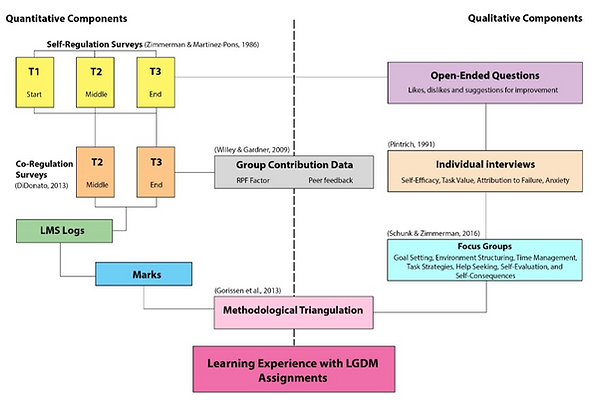
For Educators
If you would like to implement Learner-Generated Digital Media (LGDM) assignments in the classroom following our systematic approach to design, implement and evaluate in the classroom, here some of the theoretical models to apply:
The Digital Media Literacies Framework
This model is the first step to identify student training needs for digital media production (Figure 1). The Conceptual domain is about preparing a storyboard which is an essential step in the production of LGDM assignments. Students need to be training on, for example, search accurate information and writing the script for their digital media assignments. The functional domain ensures that the student receives basic guidance on the tools they will be using, for example, video editing. The audiovisual domain ensures the students understand that a set of principles underpins the production of effective digital media.
Figure 1: The Taxonomy of Digital Media Types for Teaching and Learning.
Reference:
Reyna, J., Hanham, J., & Meier, P. C. (2018). A framework for digital media literacies for teaching and learning in higher education. E-Learning and Digital Media, Vol 15(4), 176-190.
The Taxonomy of Digital Media Types
This framework needs to be used for educators and students. The taxonomy will guide the educators to understand what is involved in the production of different digital media artefacts (Figure 2). With this knowledge, it will be possible to design the assessment task and allocate the weight. This is crucial because producing digital media is a time-consuming, iterative and tedious. If the task weight is low (e.g. under 20% for a group video assignment), students will assign a low task value. Therefore this will affect their motivation to engage with the task. From the students perspective, the taxonomy could help them to visualise the skills required to complete their LGDM projects.
Figure 2: The Taxonomy of digital media types for LGDM assignments.
Reference:
Reyna, J., Hanham, J., Meier, P (2018). A taxonomy of digital media types for Learner-Generated Digital Media assignments. E-learning & Digital Media, Vol. 14(6) 309–322.
Both frameworks will help to design a marking rubric for the task. This is important as the effort students put into generating a digital artefact needs to be valued with fairness. Table 1 shows a basic structure of a marking rubric for LGDM.
Table 1: A generic example of criteria to design a marking rubric to measure communication skills in LGDM projects. The examples were created using the DMLF (Figure 1) and the TDMT (Figure 2).
The digital media principles framework
This framework will guide student training in the audiovisual domain. The evidence approach of this model relies on disciplines such as Neuroscience, Psychology (Gestalt Theory), Visual Design and Multimedia Learning Principles (Cognitive science) (Figure 3). These digital media principles are succinctly explained in the interactive modules developed for students. It is crucial that educators also complete these modules, before designing their rubrics and marking LGDM assignments.
Figure 3: The digital media Principles framework
Reference:
Reyna, J., Hanham, J., Meier, P (2018). The Internet Explosion, Digital Media Principles and Implications to Communicate Effectively in the Digital Space. E-learning & Digital Media, Vol 15, Issue 1, pp. 36 – 52.
The LGDM Implementation Framework
This framework will help educators to design the digital media task and inform the students on the rationale and workflow of the assignment (Figure 4). The inside part of the wheel contains questions the students may ask about the task, while the outer area, areas that will help educators to design the task.
Figure 4: The LGDM Implementation Framework to guide a systematic approach to digital media assignments.
Reference:
Reyna, J., Meier, P (2018). A Practical Model for Implementing Digital Media Assessments in Tertiary Science Education. American Journal of Educational Research, 6(1):27-31. doi: 10.12691/education-6-1-4.
The methodological approach to research and evaluate LGDM assignments
This framework is based on self-regulation and motivational elements to explore student self-regulation processes when they create digital media (Figure 5). The model follows a mixed-method approach and methodological triangulation to evaluate and study the quality of student learning with LGDM. This section will be of interest for educational researchers.
Figure 5: A theoretical model to research LGDM as an assessment tool in the classroom.
Reference:
Reyna, J., Hanham, J. & Meier, P. (2018). A Methodological Approach to Evaluate the Effectiveness of Learner-Generated Digital Media (LGDM) Assignments in Science Education. Proceedings of EdMedia: World Conference on Educational Media and Technology (pp. 303-314). Amsterdam, Netherlands: Association for the Advancement of Computing in Education (AACE).
If you would like a simple validated survey to evaluate your LGDM Intervention, you can consult the following paper:
Reyna, J., and Meier, PC (2018). Using the Learner-Generated Digital Media (LGDM) Framework in Tertiary Science Education: A Pilot Study. Educ. Sci. 2018, 8(3), 106, 23p.
Feel free to contact us if you have any question or suggestion. We are constantly looking for new partners to implement LGDM across disciplines in Higher Education but also primary and secondary education.









